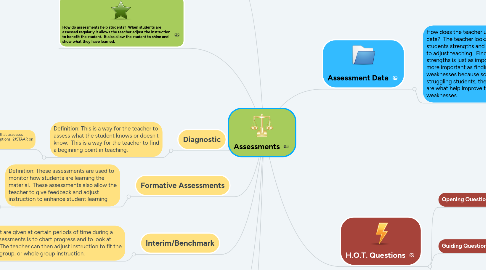
1. Formative Assessments
1.1. Definition: These assessments are used to monitor how students are learning the material. These assessments also allow the teacher to give feedback and adjust instruction to enhance student learning
1.1.1. Examples: 1) verbal or written assignments 2) quizzes or exit tickets
2. Interim/Benchmark
2.1. Definition: There are assessments that are given at certain periods of time during a school year. The purpose of these assessments is to chart progress and to look at students strengths and weaknesses. The teacher can then adjust instruction to fit the needs of an individual student, focus group, or whole group instruction.
2.1.1. Examples: 1) Beginning, middle, end of year test 2)DRA Testing
3. Summative
3.1. Definition: These assessments are used to assess the knowledge a student has gained from a large chunk of teaching. These assessments are given at the end of a unit or possibly at a midterm or final, end of year.
3.1.1. Examples: 1) Common assessment given to each student in an entire grade level at the end of a unit 2) STAAR Testing
4. Performance
4.1. Definition: These assessments require students to apply knowledge and to do something more than a simple fill in the blank or multiple choice quiz.
4.1.1. Examples: 1) Project 2) Portfolios
5. Diagnostic
5.1. Definition: This is a way for the teacher to assess what the student knows or doesn't know. This is a way for the teacher to find a beginning point in teaching.
5.1.1. Examples: 1) pre-tests that assesses knowledge or misconceptions 2)STAAR on line reading assessment
6. What assessments allow teachers to do? Assessments allow teachers to understand where students are in learning. Assessments allow teachers to adjust instruction so students can get the most from instruction.
7. How do assessments help students? When students are assessed regularly it allows the teacher adjust the instruction to benefit the student. It also allow the student to shine and show what they have learned.
8. Assessment Data
8.1. How does the teacher use the data? The teacher looks at the students strengths and weaknesses to adjust teaching. Finding the strengths is just as important or more important as finding the weaknesses because sometimes in struggling students, the strengths are what help improve the weaknesses.
8.1.1. DRA is an acronym for Developmental Reading Assessment (The goal for the end of the year is 16)(All of the strategies are done in Guided Reading groups)(Goal is to improve reading comprehension and fluency)
8.1.2. Student 1: DRA level 2
8.1.2.1. Strategies: 1) ELL strategies such as pictures of words to enhance comprehansion 2) Review high frequency sight words to 25
8.1.3. Student 2: DRA level 7
8.1.3.1. Strategies: 1) Strategies for sounding out words 2) Work on strategies for comprehension
8.1.4. Student 3: DRA level 8
8.1.4.1. Strategies: 1) Review high frequency words to 50 2) Work on comprehension strategies.
9. H.O.T. Questions
9.1. Opening Questions
9.1.1. Q1: Looking at the title and cover, what do you think the story is about? As we take a picture walk, tell me about what is happening in the story?
9.1.2. Q2: Let's look at the text, what new suffixes or prefixes do we see in the text? Are there any unfamiliar words that jump out at you?
9.2. Guiding Questions
9.2.1. Q1: As you get stuck on a word, what strategies can you use to sound out a word? (Pictures, phonics, chunking?)
9.2.2. Q2: Can you tell me about two details that the story is about so far?
9.3. Closing Questions
9.3.1. Q1: First, without looking back at the story can you tell me what happened? Was there an important lesson to be learned?
9.3.2. Q2: What was the best strategy you used today to decode words? Did you notice any patterns in the words?
